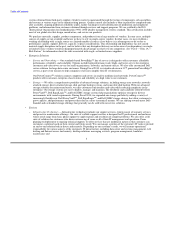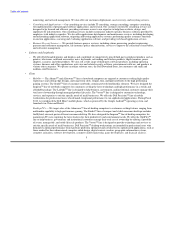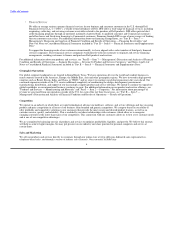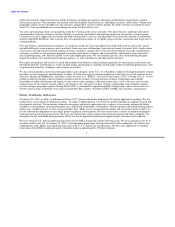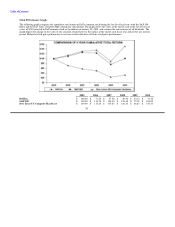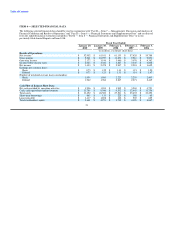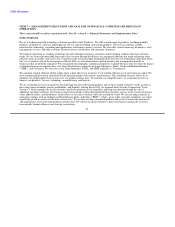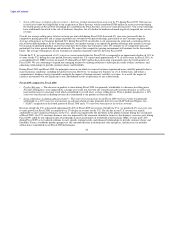Dell 2009 Annual Report Download - page 18
Download and view the complete annual report
Please find page 18 of the 2009 Dell annual report below. You can navigate through the pages in the report by either clicking on the pages listed below, or by using the keyword search tool below to find specific information within the annual report.
Table of Contents
and solutions depends on our ability to successfully transition our sales capabilities in accordance with our strategy and to add
to the breadth of our higher margin offerings through selective acquisitions of other businesses. If we are unable to effectively
manage the growth of our distribution capabilities and grow our product and services offerings, our business and results of
operations could be unfavorably affected.
• If we fail to achieve favorable pricing from our vendors, our profitability could be adversely impacted.
Our profitability is affected by our ability to achieve favorable pricing with our vendors and contract manufacturers, including
through negotiations for vendor rebates, marketing funds, and other vendor funding received in the normal course of business.
Because these supplier negotiations are continuous and reflect the ongoing competitive environment, the variability in timing
and amount of incremental vendor discounts and rebates can affect our profitability. These vendor programs may change
periodically, potentially resulting in adverse profitability trends. Our inability to establish a cost and product advantage, or
determine alternative means to deliver value to our customers, may adversely affect our industry unit share position, revenue,
and profitability.
• Our reliance on vendors for products and components, many of whom are located outside the U.S., could harm our business by
adversely affecting product delivery, reliability and cost.
We obtain many of our products and all of our components from third party vendors. In addition, we are continuing to expand
our use of contract manufacturers and manufacturing outsourcers. While these relationships generate cost efficiencies, they
reduce our direct control over production. Our manufacturing and supply chain efficiencies give us the ability to operate with
reduced levels of component and finished goods inventories. Our increasing reliance on these vendors subjects us to a greater
risk of shortages, and reduced control over delivery schedules of components and products, as well as a greater risk of increases
in product and component costs. Because we maintain minimal levels of component and product inventories, a disruption in
component or product availability could harm our financial performance and our ability to satisfy customer needs. In addition,
defective parts and products from these vendors could reduce product reliability and harm our reputation.
• We could experience manufacturing interruptions, delays, or inefficiencies if we are unable to procure in a timely and reliable
manner components and products from single-source or limited-source suppliers.
We maintain several single-source or limited-source supplier relationships, either because multiple sources are not available or
because the relationships are advantageous to us due to performance, quality, support, delivery, capacity, or price
considerations. If the supply of a critical single- or limited-source product or component is delayed or curtailed, we may not be
able to ship the related product in desired quantities and in a timely manner. Even where multiple sources of supply are
available, qualification of the alternative suppliers and establishment of reliable supplies could result in delays and a possible
loss of sales, which could harm our operating results.
• We may not successfully implement our acquisition strategy.
We acquire companies as a part of our overall growth strategy. These acquisitions may involve significant new risks and
uncertainties, including distraction of management attention away from our current business operations, insufficient new
revenue to offset expenses, inadequate return of capital, integration challenges, new regulatory requirements, and issues not
discovered in our due diligence process. As a result, such acquisitions may adversely affect our profitability or operations. In
addition, if we make changes in our business strategy or if external conditions adversely affect our business operations, we may
be forced to record an impairment charge for goodwill or intangibles, which would lead to decreased assets and reduced net
operating performance.
• Our ability to generate substantial non-U.S. net revenue faces many additional risks and uncertainties.
Sales outside the U.S. accounted for approximately 47% of our consolidated net revenue in Fiscal 2010. Our future growth rates
and success are dependent on continued growth of our business outside the U.S., including in the key developing countries of
Brazil, Russia, India, and China. Our international operations face many risks and uncertainties, including varied local
economic and labor conditions, political
14


